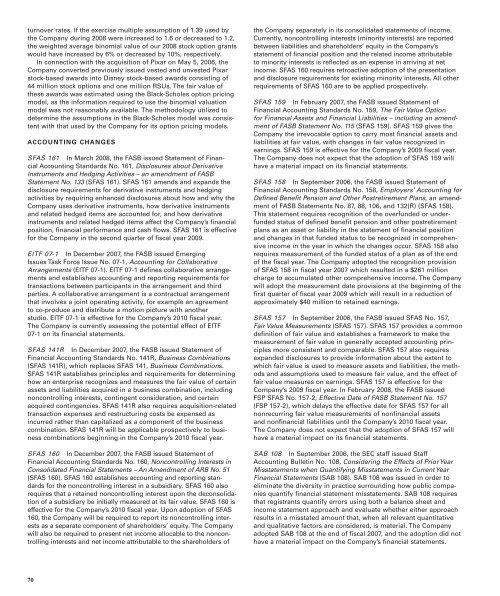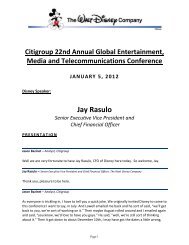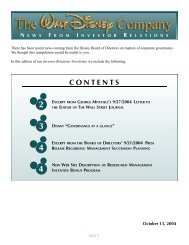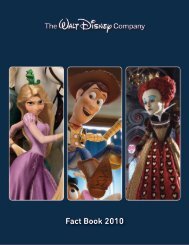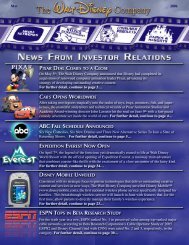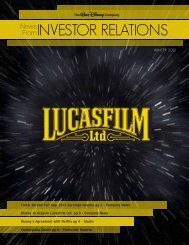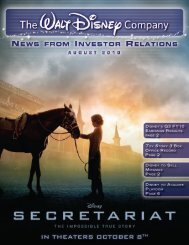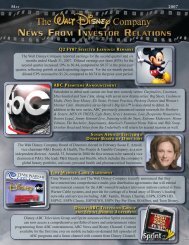Disney - The Walt Disney Company
Disney - The Walt Disney Company
Disney - The Walt Disney Company
Create successful ePaper yourself
Turn your PDF publications into a flip-book with our unique Google optimized e-Paper software.
turnover rates. If the exercise multiple assumption of 1.39 used by<br />
the <strong>Company</strong> during 2008 were increased to 1.6 or decreased to 1.2,<br />
the weighted average binomial value of our 2008 stock option grants<br />
would have increased by 6% or decreased by 10%, respectively.<br />
In connection with the acquisition of Pixar on May 5, 2006, the<br />
<strong>Company</strong> converted previously issued vested and unvested Pixar<br />
stock-based awards into <strong>Disney</strong> stock-based awards consisting of<br />
44 million stock options and one million RSUs. <strong>The</strong> fair value of<br />
these awards was estimated using the Black-Scholes option pricing<br />
model, as the information required to use the binomial valuation<br />
model was not reasonably available. <strong>The</strong> methodology utilized to<br />
determine the assumptions in the Black-Scholes model was consistent<br />
with that used by the <strong>Company</strong> for its option pricing models.<br />
ACCOUNTING CHANGES<br />
SFAS 161 In March 2008, the FASB issued Statement of Financial<br />
Accounting Standards No. 161, Disclosures about Derivative<br />
Instruments and Hedging Activities – an amendment of FASB<br />
Statement No. 133 (SFAS 161). SFAS 161 amends and expands the<br />
disclosure requirements for derivative instruments and hedging<br />
activities by requiring enhanced disclosures about how and why the<br />
<strong>Company</strong> uses derivative instruments, how derivative instruments<br />
and related hedged items are accounted for, and how derivative<br />
instruments and related hedged items affect the <strong>Company</strong>’s financial<br />
position, financial performance and cash flows. SFAS 161 is effective<br />
for the <strong>Company</strong> in the second quarter of fiscal year 2009.<br />
EITF 07-1 In December 2007, the FASB issued Emerging<br />
Issues Task Force Issue No. 07-1, Accounting for Collaborative<br />
Arrangements (EITF 07-1). EITF 07-1 defines collaborative arrangements<br />
and establishes accounting and reporting requirements for<br />
transactions between participants in the arrangement and third<br />
parties. A collaborative arrangement is a contractual arrangement<br />
that involves a joint operating activity, for example an agreement<br />
to co-produce and distribute a motion picture with another<br />
studio. EITF 07-1 is effective for the <strong>Company</strong>’s 2010 fiscal year.<br />
<strong>The</strong> <strong>Company</strong> is currently assessing the potential effect of EITF<br />
07-1 on its financial statements.<br />
SFAS 141R In December 2007, the FASB issued Statement of<br />
Financial Accounting Standards No. 141R, Business Combinations<br />
(SFAS 141R), which replaces SFAS 141, Business Combinations.<br />
SFAS 141R establishes principles and requirements for determining<br />
how an enterprise recognizes and measures the fair value of certain<br />
assets and liabilities acquired in a business combination, including<br />
noncontrolling interests, contingent consideration, and certain<br />
acquired contingencies. SFAS 141R also requires acquisition-related<br />
transaction expenses and restructuring costs be expensed as<br />
incurred rather than capitalized as a component of the business<br />
combination. SFAS 141R will be applicable prospectively to business<br />
combinations beginning in the <strong>Company</strong>’s 2010 fiscal year.<br />
SFAS 160 In December 2007, the FASB issued Statement of<br />
Financial Accounting Standards No. 160, Noncontrolling Interests in<br />
Consolidated Financial Statements – An Amendment of ARB No. 51<br />
(SFAS 160). SFAS 160 establishes accounting and reporting standards<br />
for the noncontrolling interest in a subsidiary. SFAS 160 also<br />
requires that a retained noncontrolling interest upon the deconsolidation<br />
of a subsidiary be initially measured at its fair value. SFAS 160 is<br />
effective for the <strong>Company</strong>’s 2010 fiscal year. Upon adoption of SFAS<br />
160, the <strong>Company</strong> will be required to report its noncontrolling interests<br />
as a separate component of shareholders’ equity. <strong>The</strong> <strong>Company</strong><br />
will also be required to present net income allocable to the noncontrolling<br />
interests and net income attributable to the shareholders of<br />
70<br />
the <strong>Company</strong> separately in its consolidated statements of income.<br />
Currently, noncontrolling interests (minority interests) are reported<br />
between liabilities and shareholders’ equity in the <strong>Company</strong>’s<br />
statement of financial position and the related income attributable<br />
to minority interests is reflected as an expense in arriving at net<br />
income. SFAS 160 requires retroactive adoption of the presentation<br />
and disclosure requirements for existing minority interests. All other<br />
requirements of SFAS 160 are to be applied prospectively.<br />
SFAS 159 In February 2007, the FASB issued Statement of<br />
Financial Accounting Standards No. 159, <strong>The</strong> Fair Value Option<br />
for Financial Assets and Financial Liabilities – including an amendment<br />
of FASB Statement No. 115 (SFAS 159). SFAS 159 gives the<br />
<strong>Company</strong> the irrevocable option to carry most financial assets and<br />
liabilities at fair value, with changes in fair value recognized in<br />
earnings. SFAS 159 is effective for the <strong>Company</strong>’s 2009 fiscal year.<br />
<strong>The</strong> <strong>Company</strong> does not expect that the adoption of SFAS 159 will<br />
have a material impact on its financial statements.<br />
SFAS 158 In September 2006, the FASB issued Statement of<br />
Financial Accounting Standards No. 158, Employers’ Accounting for<br />
Defined Benefit Pension and Other Postretirement Plans, an amendment<br />
of FASB Statements No. 87, 88, 106, and 132(R) (SFAS 158).<br />
This statement requires recognition of the overfunded or underfunded<br />
status of defined benefit pension and other postretirement<br />
plans as an asset or liability in the statement of financial position<br />
and changes in that funded status to be recognized in comprehensive<br />
income in the year in which the changes occur. SFAS 158 also<br />
requires measurement of the funded status of a plan as of the end<br />
of the fiscal year. <strong>The</strong> <strong>Company</strong> adopted the recognition provision<br />
of SFAS 158 in fiscal year 2007 which resulted in a $261 million<br />
charge to accumulated other comprehensive income. <strong>The</strong> <strong>Company</strong><br />
will adopt the measurement date provisions at the beginning of the<br />
first quarter of fiscal year 2009 which will result in a reduction of<br />
approximately $40 million to retained earnings.<br />
SFAS 157 In September 2006, the FASB issued SFAS No. 157,<br />
Fair Value Measurements (SFAS 157). SFAS 157 provides a common<br />
definition of fair value and establishes a framework to make the<br />
measurement of fair value in generally accepted accounting principles<br />
more consistent and comparable. SFAS 157 also requires<br />
expanded disclosures to provide information about the extent to<br />
which fair value is used to measure assets and liabilities, the methods<br />
and assumptions used to measure fair value, and the effect of<br />
fair value measures on earnings. SFAS 157 is effective for the<br />
<strong>Company</strong>’s 2009 fiscal year. In February 2008, the FASB issued<br />
FSP SFAS No. 157-2, Effective Date of FASB Statement No. 157<br />
(FSP 157-2), which delays the effective date for SFAS 157 for all<br />
nonrecurring fair value measurements of nonfinancial assets<br />
and nonfinancial liabilities until the <strong>Company</strong>’s 2010 fiscal year.<br />
<strong>The</strong> <strong>Company</strong> does not expect that the adoption of SFAS 157 will<br />
have a material impact on its financial statements.<br />
SAB 108 In September 2006, the SEC staff issued Staff<br />
Accounting Bulletin No. 108, Considering the Effects of PriorYear<br />
Misstatements when Quantifying Misstatements in CurrentYear<br />
Financial Statements (SAB 108). SAB 108 was issued in order to<br />
eliminate the diversity in practice surrounding how public companies<br />
quantify financial statement misstatements. SAB 108 requires<br />
that registrants quantify errors using both a balance sheet and<br />
income statement approach and evaluate whether either approach<br />
results in a misstated amount that, when all relevant quantitative<br />
and qualitative factors are considered, is material. <strong>The</strong> <strong>Company</strong><br />
adopted SAB 108 at the end of fiscal 2007, and the adoption did not<br />
have a material impact on the <strong>Company</strong>’s financial statements.


